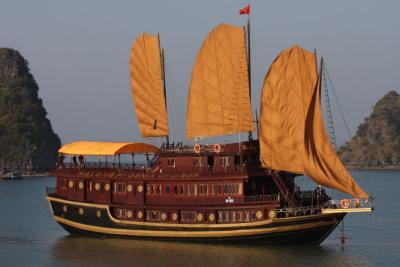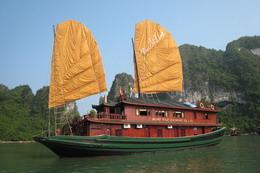Tomb of the Emperor
Published: 12/03/2011 05:00
| The zenith of the Nguyen Dynasty was reached during the reign of Emperor Minh Mang (1820 – 1840) who was known not only as the Nguyen Dynasty’s most powerful king but also for his hundreds of royal concubines and 142 children.
Located on Cam Ke Mountain (Golden Cock Mountain) about 12 kilometers from Hue city City, Minh Mang’s Tomb was built over four years (1840 – 1843) by 10,000 soldiers and workers. Observing strictly geomantic rules, the tomb consists of about 40 monuments of various dimensions. All lie within a wall that is oval in shape and 2,000 meters in circumference.
Running east-west from the Dai Hong Gate to the farthest part of the surrounding wall, the main axis of the tomb is more than 700 meters long. The most important constructions along the wall are the Salutation Court, Stele House, Sung An Temple, Minh Lau Pavillion and the tomb. Secondary monuments are symmetrically arranged in pairs. Most of the monuments mirror themselves in man-made lakes, especially the romantic lake of Trung Minh where the Emperor placed the Nghenh Luong Pavillion (Pavillion for Welcoming Pillars). The tomb planning reflects the strict social organization in Minh Mang times, the centralism and the monarch’s Confucian doctrines. Tourists are attracted to the tomb’s solemnity and symmetry. Like other tombs in Hue Ancient Capital that have been damaged by wars and natural calamities, Minh Mang Tomb was listed in the world’s most endangered sites in 2000. However, with financial support from UNESCO and other sponsors, it has been restored. Along with King Tu Duc Tomb, it is a popular heritage site in Hue. Source: SGT |
Provide by Vietnam Travel
Tomb of the Emperor - Travel - News | vietnam travel company
You can see more
- Travel trends in 2023
- In the spring, Moc Chau is covered in plum blossoms.
- Top 3 Special festivals in Vietnam during Tet holiday - 2023
- 5 tourist hotspots expected to see a spike in visitors during Lunar New Year 2023
- 12 Days Cycling From Vietnam to Laos
- Why You Should Cycle To Cuc Phuong National Park?
- Top 10 Must-see Sights In Hanoi, Vietnam
- The Most Wonderful Destinations In Sapa
enews & updates
Sign up to receive breaking news as well as receive other site updates!
- Banh Đa Cua - a traditional Hai Phong specialty
- Exploring Lai Chau cuisine
- Hanoi ranked top 3 cuisine in the world in 2023
- Beautiful resorts for a weekend escape close to Hanoi
- Travel trends in 2023
- In the spring, Moc Chau is covered in plum blossoms.
- The Most Wonderful Destinations In Sapa
- Top 3 Special festivals in Vietnam during Tet holiday - 2023
- 5 tourist hotspots expected to see a spike in visitors during Lunar New Year 2023
- How To Make Kitchen Cleaned
-
vietnam travel
http://www.vietnamtourism.org.vn " Vietnam Tourism: Vietnam Travel Guide, Culture, Travel, Entertainment, Guide, News, and...
-
Vietnam culture, culture travel
http://travel.org.vn " Vietnam culture
-
Vietnam travel, vietnam travel news, vietnam in photos
http://www.nccorp.vn " Vietnam travel, vietnam travel news, vietnam in photos
-
Vietnam tourism
http://www.vietnamtourism.org.vn " The official online information on culture, travel, entertainment, and including facts, maps,...
-
Vietnam Travel and Tourism
http://www.vietnamtourism.org.vn/ " Vietnam Travel, Entertainment, People, Agents, Company, Vietnam Tourism information.
-
Information travel online
http://www.travellive.org "Information travel online













